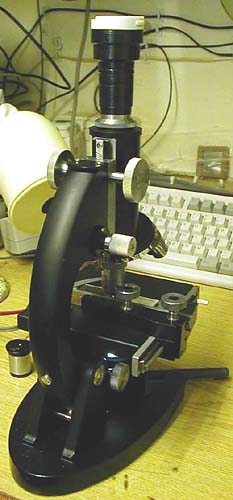I put my name down a long time ago at some schools and hospitals for a compound microscope if an old one became available. Well, I got a phone call from a local school who have closed a biology lab. The short story is, that with a loan from a friend, I bought the lot! I am now the proud owner of six compound scopes (four Meoptas, one Opax and an Olympus HSC, all with mechanical stages and substages)!At least three of these have to be sold to recoup at least some of the outlay, so I have advertised them and put them on my web site. They are all in top condition and wooden cased. Anyway that's the news. Now for the latest project.
Having adapted the Creative Labs webcam onto the Nikon stereo microscope (see part one), I wondered if I could get my digital camera coupled to one of the compound microscopes. The digicam is an Olympus C-960 Zoom, but has a retracting lens unit with no way of attaching further lenses. A long look round the house did not come up with anything that would fit over the lens housing, so out to the garage next! I found a piece of standard waste pipe fitted exactly over the housing and a one inch piece was duly cut.
Next thing was to find a lens that would focus the microscope image full screen into the zoom lens of the camera. In my radio shack/workshop/fish house/biology lab are many parts from failed boot sale purchases. Among these is a box of old video camera parts and lenses from duff ones I have stripped. (Never throw things away!) I patiently tried all these until I found one that, using the camera's digital and optical zooms, would fill the screen.
I then measured the distances to set the lens and the camera above the microscope and started searching again for some method to attach them all together. What I needed was something that would fit into the piece of waste pipe and also take the diameter of the lens.
After about an hour searching the house and bathroom, garage and every other place I could think, I came across a reel of 'Magic' tape. Voilà! The plastic reel holding this tape fitted perfectly into the waste pipe and the lens was almost a perfect fit into the center! A bit of cutting, cleaning, supergluing and taping with black insulation tape later, it was almost done.
The Olympus camera is operated by sliding open the lens cover which starts a motor to wind out the lens. This can cause a problem as it is easy to accidentally push the cover and retract the lens, switching the camera off. I got round this by gluing a small piece of plastic onto the waste pipe part of the attachment to prevent the cover returning and switching the camera off. This needs to be done, as if the fitting onto the camera lens is tight and the lens tries to retract, it could damage the motor or gears in the camera. This adaptation can be seen in the attached photos.
Once everything was checked and glued well, I covered the lot in half-inch thin black tape to stop any extraneous light getting in. Over to the fish tank for a bit of algae and away we go, snapping like mad! First attempts with the camera on auto were not too bad, but more light was needed, so I set it up for +1 on the aperture and set the speed for ISO 250 and tried again.
Much better now, but I still need to experiment a lot more with the settings. All the pictures were taken using the Opax compound microsope with the X10 objective and a 20W tungsten Olympus light source and the substage iris fully closed. Comparing the pictures to visual views taken using the eyepiece, I would guess that using the camera gives about X100 magnification, which you can judge from the photos.
Anyway I do hope this second sample from the Heath Robinson selection is of some help or inspiration to someone!
Comments to the author David Bull are welcomed.
Visit the author's home pages where he shares further information and his other interests.
Stages in building the home-made microscope adaptor for the Olympus C-960 digicam.
(Camera pictures were taken with a Creative Webcam Go Plus.)
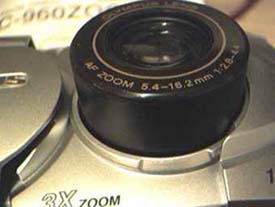
The fixed lens of the Olympus C-960 zoom digicam. The open lens door is shown left.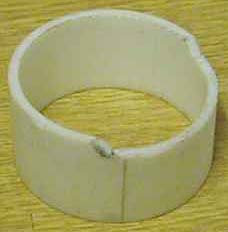
A section of waste pipe with a notch to cut out to fit over the lens of the digicam.
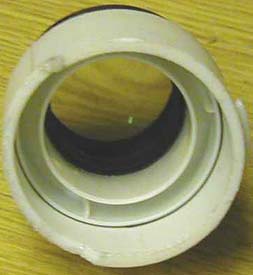
A discarded tape reel sits snugly in the pipe to mount the relay lens.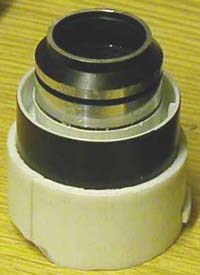
An old video camera lens mounted in the adaptor acts as a relay lens.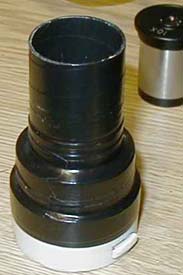
The adaptor is finished off with black tape to prevent light leaking in. Note the extra peg at the bottom to prevent the digicam lens door moving which would retract the zoom lens.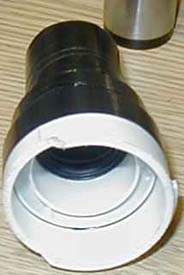
A neat, cheap but effective adaptor ready for use.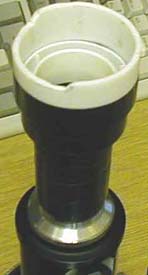
Image above: The completed adaptor with relay lens on the microscope.Image right: An overall view of the microscope with attached adaptor. The digicam is not attached. (It was used to take the picture!)
A selection of images of freshwater life taken with the above set-up.
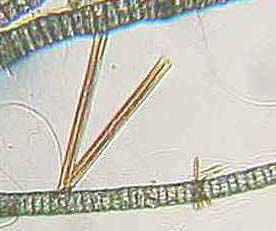
Epiphytic diatoms on filamentous algae.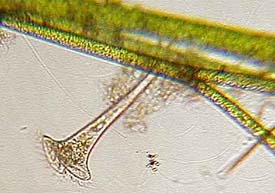
Stentor on filamentous algae.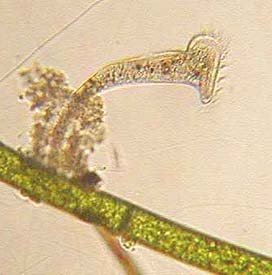
Stentor on filamentous algae.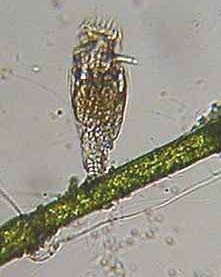
Rotifer attached to algae.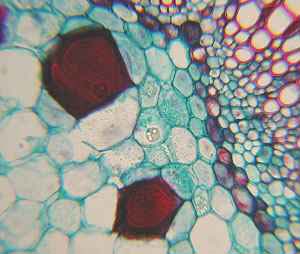
Stained cross section of Tilia stem.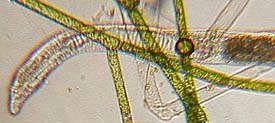
Tiny worm amongst algae.
